- News & information
- About
- History
- George V. Voinovich
- George V. Voinovich Collection
- Calendar
- How to Find Us
- News
- Archives
- Photojournalism Fellowship Project
- Photo Essays
- Current Fellow
- Previous Fellows
- Reports and Publications
- Archives
- Students
- Prospective
- Center for Entrepreneurship
- Environmental Studies
- HTC/Voinovich School Scholars
- Master of Public Administration
- Current
- HTC/Voinovich School Scholars
- Center for Entrepreneurship
- Environmental Studies
- Master of Public Administration
- Alumni
- Contact
- School Leadership
- Strategic Partners Alliance
- Ohio University Public Affairs Advisory Committee
- Ohio University Public Affairs Advisory Committee
- Faculty and Fellows
- Faculty
- Visiting Professors
- Voinovich Fellows
- Professional Staff
| Lawrence M. Witmer,
PhD
|
 |
Juvenile skull of the tyrannosaurid dinosaur Tarbosaurus bataar |
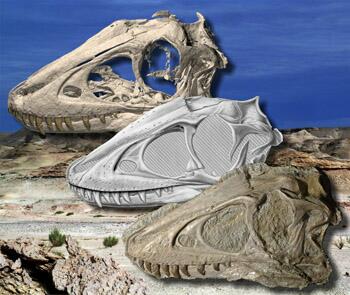 Common Language Summary
Common Language Summary
Juvenile Tarbosaurus
shows shifting
tyrannosaur lifestyles.
A newly discovered skull of a very young individual of Tarbosaurus bataar
helps shed new light on the biology of
this closest relative of North America’s T. rex
. In 2006,
a joint expedition by the Hayashibara Museum of Natural Science
and the Mongolian Paleontological Center to the Bugin Tsav
locality of the Upper Cretaceous Nemegt Formation in the western
Gobi Desert of Mongolia uncovered the youngest, most complete
skeleton of a tyrannosaur yet found. Bone microstructure reveals
that the animal was just 2–3 years old when it died. The skull
of this juvenile is extremely well preserved and is the focus of
this largely descriptive study. Key findings are that the skull
of this young animal was clearly not well adapted for the
hard-biting, bone-crunching lifestyle of the adult. Absent are
the reinforcing mechanisms, bony buttresses, and large muscle
attachment sites that allowed older individuals to deliver and
withstand high bite forces and otherwise dangerous twisting
movements. Because their skulls were more delicate, juveniles
must have fed on different prey types than adults, relying more
on speed and agility than power. They would have had to have
taken smaller prey that would not have struggled as much,
because their skulls couldn’t handle the stress. The juvenile
skull is also important because it’s among the very few young
tyrannosaur skulls that can unequivocally be identified to
species, and so sheds important light on more controversial
isolated finds, such as specimens referred to Nanotyrannus
, Shanshanosaurus
, and Raptorex
. CT scanning of the
skull reveals important details of its anatomy, and a future
study will report the findings on the brain cavity, inner ear,
and other soft tissues.
• Download a PDF of the published article:
Tsuihiji, T., M. Watabe, K. Tsogtbaatar, T. Tsubamoto, R. Barsbold, S. Suzuki, A. H. Lee, R. C. Ridgely, Y. Kawahara, and L. M. Witmer . 2011. Cranial osteology of a juvenile specimen of Tarbosaurus bataar from the Nemegt Formation (Upper Cretaceous) of Bugin Tsav, Mongolia. Journal of Vertebrate Paleontology . 31(3):497–517.
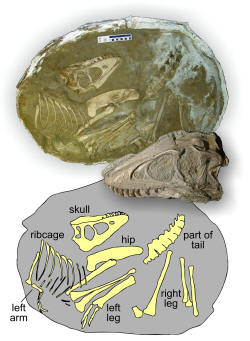
The youngest and most complete skeleton including a skull of a tyrannosaur ever found. This 2-year-old individual of Tarbosaurus discovered in Cretaceous rocks in Mongolia weighed only 70 pounds but would have grown up to be a 6-ton mega-predator. Courtesy of the Hayashibara Museum of Natural Sciences and WitmerLab at Ohio University.
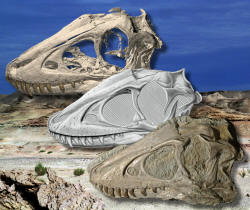
Skull of a 2-year-old juvenile Tarbosaurus , a Cretaceous tyrannosaur from Mongolia. The skull is represented by a photograph (lower right), a drawing (center), and a computer rendering with rock removed based on CT scanning (top left). Courtesy of the Hayashibara Museum of Natural Sciences and WitmerLab at Ohio University.
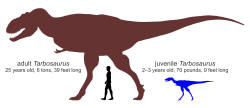 Silhouettes of an adult Tarbosaurus
and the newly discovered juvenile, along with a
human for scale. Courtesy of the Hayashibara Museum of Natural
Sciences.
Silhouettes of an adult Tarbosaurus
and the newly discovered juvenile, along with a
human for scale. Courtesy of the Hayashibara Museum of Natural
Sciences.
Skull of a 2-year-old juvenile Tarbosaurus , a Cretaceous tyrannosaur from Mongolia, with an adult skull at right and a teenage skull behind for comparison. Courtesy of WitmerLab at Ohio University.
• Download a 21 MB QuickTime version (HD: 1920x1080)
• Download a 12 MB QuickTime version (1280x720)
• Download a 7 MB QuickTime version (853x480)
Animation of the skull of a newly discovered juvenile specimen of
the Mongolian tyrannosaur Tarbosaurus
with the bones and some other anatomical structures labeled.
The
juvenile was only 2-3 years old when
it died, providing insight into
the growth and changing
lifestyles of tyrannosaurs.
Animation by Ridgely and Witmer,
Courtesy of WitmerLab at Ohio
University.
•
Download a
28 MB QuickTime version (HD:
1920x1080)
•
Download a
15 MB QuickTime version
(1280x720)
•
Download a
9 MB QuickTime version (853x480)
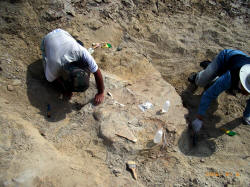
In 2006, workers from the Hayashibara Museum of Science and Mongolian Paleontological Center (including study coauthors, Yasuhiro Kawahara, left, and Takehisa Tsubamoto, right) excavated the skeleton of the juvenile Tarbosaurus from 70-million-year-old rocks in Mongolia. Courtesy of the Hayashibara Museum of Natural Sciences.
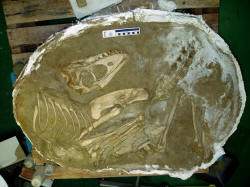
The youngest and most complete skeleton including a skull of a tyrannosaur ever found. This 2-year-old individual of Tarbosaurus discovered in Cretaceous rocks in Mongolia weighed only 70 pounds but would have grown up to be a 6-ton mega-predator. Courtesy of the Hayashibara Museum of Natural Sciences.
Immature skull led young tyrannosaurs to rely on speed, agility
to catch prey
New study suggests range of feeding strategies for juvenile,
adult predators
ATHENS, Ohio (May 9, 2011)—While adult tyrannosaurs wielded power and size to kill large prey, youngsters used agility to hunt smaller game.
“It’s one of the secrets of success for tyrannosaurs—the different age groups weren’t competing with each other for food because their diets shifted as they grew,” said Ohio University paleontologist Lawrence Witmer.
Witmer is part of an international team of scientists from Japan, Mongolia and the United States that analyzed the youngest and most-complete known skull for any species of tyrannosaur, offering a new view of the growth and feeding strategies of these fearsome predators. The 70-million-year-old skull comes from a very young individual of the Mongolian dinosaur species known as Tarbosaurus bataar , the closest known relative of T. rex .
The analysis of the 11.4-inch skull, published in the Journal of Vertebrate Paleontology , revealed changes in skull structure that suggest that young tyrannosaurs had a different lifestyle than adults.
“We knew that adult Tarbosaurus were a lot like T. rex ,” said lead author Takanobu Tsuihiji, a former Ohio University postdoctoral fellow who is now a postdoctoral researcher at the National Museum of Nature and Science in Tokyo. “Adults show features throughout the skull associated with a powerful bite…large muscle attachments, bony buttresses, specialized teeth. The juvenile is so young that it doesn’t really have any of these features yet, and so it must have been feeding quite differently from its parents.”
The skull was found as part of an almost complete skeleton, missing only the neck and a portion of the tail. Based on careful analysis of the microstructure of the legs bones, co-author Andrew Lee of Ohio University (now at Midwestern University) estimated that the juvenile was only 2 to 3 years old when it died. It was about 9 feet in total length, about 3 feet high at the hip and weighed about 70 pounds. In comparison, Tarbosaurus adults were 35 to 40 feet long, 15 feet high, weighed about 6 tons and probably had a life expectancy of about 25 years, based on comparison with T. rex .
“This little guy may have been only 2 or 3, but it was no toddler…although it does give new meaning to the phrase ‘terrible twos,’” said Witmer, Chang Professor of Paleontology at the Ohio University College of Osteopathic Medicine. “We don’t know to what extent its parents were bringing it food, and so it was probably already a pretty capable hunter. Its skull wasn’t as strong as the adult’s, and would have had to have been a more careful hunter, using quickness and agility rather than raw power.”
The different hunting strategies of juveniles and adults may have reduced competition among Tarbosaurus and strengthened their role as the dominant predators of their environment.
“The juvenile skull shows that there must have a change in dietary niches as the animals got older,” Tsuihiji said. “The younger animals would have taken smaller prey that they could subdue without risking damage to their skulls, whereas the older animals and adults had progressively stronger skulls that would have allowed taking larger, more dangerous prey.”
The late Cretaceous environment offered plenty of options for prey.
“ Tarbosaurus is found in the same rocks as giant herbivorous dinosaurs like the long-necked sauropod Opisthocoelicaudia and the duckbill hadrosaur Saurolophus ,” said Mahito Watabe of the Hayashibara Museum of Natural Sciences in Okayama, who led the expedition to Mongolia in 2006 that uncovered the new skull. “But the young juvenile Tarbosaurus would have hunted smaller prey, perhaps something like the bony-headed dinosaur Prenocephale .”
The juvenile skull also is important because it helps clarify the identity of small, potentially juvenile specimens of other tyrannosaur species previously found.
“The beauty of our new young skull is that we absolutely know for many good reasons that it’s Tarbosaurus ,” Witmer said. “We can use this known growth series to get a better sense of whether some of these more controversial finds grew up to be Tarbosaurus , Tyrannosaurus or some other species.”
Other authors on the article include Khishigjav Tsogtbaatar and Rinchen Barsbold of the Mongolian Paleontological Center; Takehisa Tsubamoto, Shigeru Suzuki and Yasuhiro Kawahara of the Hayashibara Biochemical Laboratories; and Ryan Ridgely of the WitmerLab at Ohio University. The research was funded by grants to Tsuihiji from the Japan Society of Promotion of Science and to Witmer and Ridgely from the U.S. National Science Foundation. The field work was supported by the Hayashibara Company Limited, Olympus, Mitsubishi Motor Company and Panasonic.
Editors: Related images and animations created by the WitmerLab can be downloaded here: Tarbosaurus_skull.htm . A fact sheet can be accessed here: juvenile_tyrannosaur/Juvenile_tyrannosaur_facts_and_graphics.pdf .
Contacts:
1. USA (Eastern Daylight Savings time): Lawrence Witmer, (740)
593-9489 and (740) 591-7712,
witmerL@ohio.edu
.
2. Japan: Takanobu Tsuihiji, National Museum of Nature and Science, Tokyo, Japan, taka@kahaku.go.jp ; +81-3-3364-2311 Ext. 7238. Mahito Watabe, Hayashibara Museum of Natural Sciences, Okayama, Japan, moldavicum@pa2.so-net.ne.jp , +81-86-224-4311.
This project was funded by grants from the National Science Foundation .
| Ohio University Heritage College of Osteopathic Medicine Irvine Hall, Athens, Ohio 45701 740-593-2530 740-597-2778 fax |
Last updated:10/13/2017
Contact Information:
(740) 593–9381 | Building 21, The Ridges
Ohio University Contact Information:
Ohio University | Athens OH 45701 | 740.593.1000 ADA Compliance | © 2018 Ohio University . All rights reserved.


















